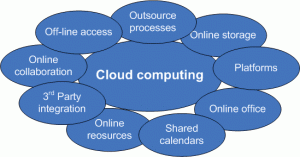The Era of Control: It’s Over
 Remember Attack Plan R? That’s the one that enabled Brigadier General Ripper to bypass General Turgidson and the rest of the Air Force chain of command, sending his bombers on an unauthorized mission to attack the Soviet Union. As a result of Plan R and two missed communications – the Soviets’ failure to announce the Doomsday Device and an encrypted radio’s failure to recall Major Kong’s B-52 – General Ripper ended the world and protected our precious bodily fluids, Colonel Mandrake’s best efforts notwithstanding.
Remember Attack Plan R? That’s the one that enabled Brigadier General Ripper to bypass General Turgidson and the rest of the Air Force chain of command, sending his bombers on an unauthorized mission to attack the Soviet Union. As a result of Plan R and two missed communications – the Soviets’ failure to announce the Doomsday Device and an encrypted radio’s failure to recall Major Kong’s B-52 – General Ripper ended the world and protected our precious bodily fluids, Colonel Mandrake’s best efforts notwithstanding.
Fortunately, we’re talking about Sterling Hayden, George C. Scott, Slim Pickens, and Peter Sellers in Stanley Kubrick’s Dr. Strangelove, or How I Learned to Stop Worrying and Love the Bomb, and not an actual event. But it’s a classic illustration why control of key technologies is important, and it’s the introduction to my theme for today: we’re losing control of key technologies, which is important and has implications for how campus IT leaders do their jobs. We can afford to lose control; we can’t afford to lose influence.
Here’s how IT was on most campuses until about ten years ago:
- There were a bunch of central applications: a financial system, a student-registration system, some web servers, maybe an instructional-management system, and then some more basic central facilities such as email and shared file storage.
- Those applications and services were all managed by college or university employees – usually in the central IT shop, but sometimes in academic or administrative units – and they ran on mainframes or servers owned and operated likewise.
- Students, faculty, and staff used the central applications from desktop and laptop computers. Amazing as it seems today, students often obtained their computers from the campus computer reseller or bookstore, or at least followed the institution’s advice if they bought them elsewhere. Faculty and staff computers were very typically purchased by the college or university and assigned to users. In all three cases, a great deal of the software on users’ computers was procured, configured, and/or installed by college or university staff.
- Personal computers and workstations connected to central applications and services over the campus network. The campus network, mostly wired but increasingly wireless, was provided and managed by the central IT organization, or in some cases by academic units.
- Campus telephony consisted primarily of office, dormitory, and “public” telephone sets connected to a campus telephone exchange, which was either operated by campus staff or operated by an outside vendor under contract to the campus.
![]() Notice the dominant feature of that list: all the key elements of campus information technology were provided, controlled, or at least strongly guided by the college or university, either through its central IT organization or through academic or administrative units.
Notice the dominant feature of that list: all the key elements of campus information technology were provided, controlled, or at least strongly guided by the college or university, either through its central IT organization or through academic or administrative units.
There were exceptions to campus control over information technology, to be sure. The World Wide Web was already a major source of academic information. Although some academic material on the web came from campus servers, most of it didn’t. There were also many services available over the web, but most campus use of these was for personal rather than campus purposes (banking, for example, and travel planning). Most campus libraries relied heavily on outside services, some accessible through the Web and some through other client/server mechanisms. And many researchers, especially in physics and other computationally-intensive disciplines, routinely used shared computational resources located in research centers or on other campuses. Regardless, a decade ago central or departmental campus IT organizations controlled most campus IT.
Now fast forward to the present, when things are quite different. The first difference is complexity. For example, I described my own IT environment in a post a few weeks ago:
I started typing this using Windows Live Writer (Microsoft) on the Windows 7 (Microsoft, but a different part) computer (Dell) that is connected to the network (Comcast, Motorola, Cisco) in my home office, and it’ll be stored on my network hard drive (Seagate) and eventually be posted using the blog service (WordPress) on the hosting service (HostMonster) where my website and blog reside. I’ll keep track of blog readers using an analytic service (Google), and when I’m traveling I might correct typos in the post using another blog editor (BlogPress) on my iPhone (Apple) communicating over cellular (AT&T) or WiFi (could be anyone) circuits. Much of today’s IT is like this: it involves user-owned technologies like computers and phones combined in complicated ways with cloud-based services from outside providers. We’re always partly in the cloud, and partly on the ground, partly in control and partly at the mercy of providers.
Mélanges like this are pretty much the norm these days. And not just when people are working from home as I often do: the same is increasingly true at the office, for faculty and staff, and in class and dorms, for students. It’s true even of the facilities and services we might still think of as institutional: administrative systems and core services, for example.
 The mélanges are complex, as I already pointed out, but their complexity goes beyond technical integration. That’s the second difference between the past and the present: not only does IT involve a lot of interrelated yet distinct pieces, but the pieces typically come from outside providers – the cloud, in the current usage. Those outside providers operate outside campus control.
The mélanges are complex, as I already pointed out, but their complexity goes beyond technical integration. That’s the second difference between the past and the present: not only does IT involve a lot of interrelated yet distinct pieces, but the pieces typically come from outside providers – the cloud, in the current usage. Those outside providers operate outside campus control.
Group the items I listed in my ten-years-ago list above into four categories: servers and data centers, central services and applications, personal computers and workstations, and the networks that interconnect them. Now consider how IT is on today’s campus:
- Instead of buying new servers and housing them in campus buildings, campuses increasingly create servers within virtualization environments, house those environments in off-campus facilities perhaps provided by commercial hosting firms, and use the hosting firm’s infrastructure rather than their own.
- A rapidly growing fraction of central services is outsourced, which means not only that servers are off campus and proprietary, but that the applications and services are being administered by outside firms.
- Although most campuses still operate wired and wireless networks, users increasingly reach “campus” services through smartphones, tablets, web-enabled televisions, and portable computers whose default connectivity is provided by telephone companies or by commercial network providers.
- Those smartphones, tablets, and televisions, and even many of the portable computers, are chosen, procured, configured, and maintained individual users, not by the institution.
This migration from institutional to external or personal control is what we mean by “cloud services”. That is, the key change is not the location of servers, the architecture of applications, the management of networks, or the procurement of personal computers. Rather, it is our willingness to give up authority over IT resources, to trade control for economy of scale and cost containment. It’s Attack Plan R.
The tradeoff has at least four important consequences. Three of these have received widespread attention, and I won’t delve into them here: ceding control to the cloud
- can introduce very real security, privacy, and legal risks,
- can undercut long-established mechanisms designed to produce effective user support at minimal cost, and
- can restructure IT costs and funding mechanisms.
 I want to focus here on the fourth consequence. Ceding control to the cloud necessarily entails a fundamental shift in the role of central and departmental IT organizations. This shift requires CIOs and IT staff to change their ways if they are to continue being effective – being Rippers, Kongs, or Turgidsons won’t work any more.
I want to focus here on the fourth consequence. Ceding control to the cloud necessarily entails a fundamental shift in the role of central and departmental IT organizations. This shift requires CIOs and IT staff to change their ways if they are to continue being effective – being Rippers, Kongs, or Turgidsons won’t work any more.
Most important, cloud-driven loss of campus control over the IT environment means that organizational and management models based on ownership, faith, authority, and hierarchy – however benevolent, inclusive, and open – will give way to models based on persuasion, negotiation, contracting, and assessment. It will become relatively less important for CIOs to be skilled at managing large organizations, and more important for them to know how to define, specify, and measure costs and results and to negotiate intramural agreements and extramural contracts consistently. Cost-effective use of cloud services also requires standardization, since nothing drives costs up and vendors away quite so quickly as idiosyncrasy. Migration to the cloud thus requires that CIOs understand emerging standards, especially for database schemas, security models, virtualization, system interfaces, and on and on. It requires that CIOs understand that strength lies in numbers – especially in campuses banding together to procure services rather than in departures from the norm, however innovative.
Almost as important, much of what campuses now achieve through regulation they will need to achieve through persuasion – policy will give way to pedagogy as the dominant mechanism for guiding users and units. I serve on the operations advisory committee for a federal agency. To ensure data and program integrity, the agency’s IT organization wanted to revise policies to regulate staff use of personal computers and small mobile devices to do their work from home or while traveling. It became rapidly clear, as the advisory committee reacted to this, that although it was perfectly possible to write policies governing the use of personal and mobile devices, most of those policies would be ignored unless the agency mounted a major educational campaign. Then it became clear that if there were a major educational campaign, this would minimize the need for policy changes. This is the kind of transition we can imagine in higher education: we need to help users to do the right thing, not just tell them.
On occasion I’ve described my core management approaches as “bribery” and “conspiracy”. This meant that as CIO my job was was to make what was best for the university also be what was most appealing to individuals (that’s “bribery”), and that figuring out what was best for the university required discussion, collaboration, and agreement among a broad array of IT and non-IT campus leaders (“conspiracy”). As control gives way to the cloud for campus IT, these two approaches become equally relevant to vendor relations and inter-institutional joint action. We who provide information technology to higher education need to work together to ensure that as we lose control over IT resources we don’t also lose influence.




